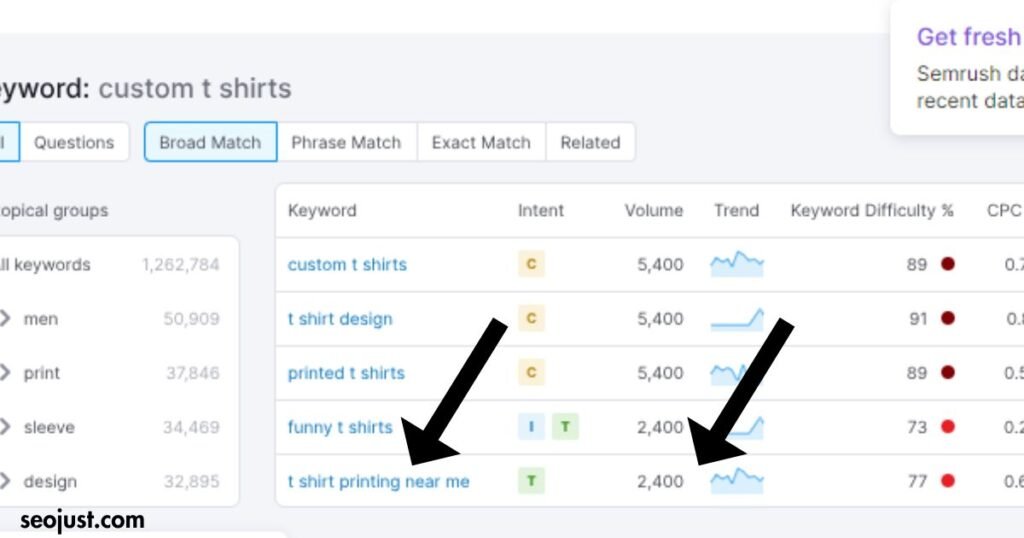Keyword research is the most important part of creating content and ranking your website on Google. This guide will pace you through keyword research and show you how to do it like a pro.
This complete guide will take your keyword research game to the next level. We’ll explore advanced methods that tap into user intent, attach the power of long-tail keywords, divide competitor strategies, fine-tune On-page SEO, improve for voice search, and frequently display and improve your keyword performance.

What Is Keyword Research?
Keyword research is the most important part of Search Engine Optimization (SEO) and content marketing plans, guiding creators and marketers toward empathy with what users are searching for online.
It involves classifying the terms, expressions, and questions that possible customers use in search engines, allowing content creators to modify their output to meet the audience’s needs. This practice helps classify topics that interest your target audience and exposes the language they use to describe their problems, desires, and questions.
By aligning your content with these insights, you can increase the visibility of your website or blog, attract more relevant traffic, and finally, improve conversion rates. Keyword research is about understanding your audience’s intent and valuable content that resolves their queries, building trust and specialists in your field.
Understanding User Intent
Before you even begin to type a keyword into a research tool, you should have a solid idea of why somebody would search for that term. User intent goes outside the search query to the ‘why’ behind it. This motivation typically falls into four categories:
Informational Intent
Users seek information, such as how-to guides, news, or answers to questions.
Navigational Intent
The user wants to go to a specific website, like typing in “Twitter” to go straight to the social media platform.
Transactional Intent
When a user is looking to make a purchase or needs information before making a purchase decision.
Commercial Intent
This is when a user looks to parallel products or services before purchasing.
Aligning your content with suitable user intent is essential for bringing value and improving your SEO. But how can you be sure you’re beating the nail on the head?
Strategies to Identify and Analyze Different Types of User Intent:
- Review Search Engine Results Pages (SERPs): • Study the top-ranking pages for your keyword. Are they informational, transactional, or something different? This can give you a good idea of the user intent behind those keywords.
- Use Google Autocomplete and Related Searches: The optional searches and related expressions can give you insight into the wider context of what the user may observe.
- Utilize Tools like Ahrefs and SEMrush: These platforms often deliver information about the intent behind a keyword. For example, they might tell you if a keyword tends to have more transactional intent than informational.
- Survey Your Audience: Sometimes asking your readers through survey forms or reading comments on similar content can provide insight into what they want.
Evolving with Intent
User intent isn’t static it can change over time. With the developing dynamics of the digital land, it’s important to keep a pulse on user ways and adapt your keyword and content plans.
Also Read: The Ultimate 2024 Guide to Content Distribution Strategy for Maximum Impact

Leveraging Long-Tail Keywords
Long-tail keywords are the specific, often longer, keyword phrases visitors are likelier to use when they’re faster to a point-of-buying or using voice search. They are precious for several reasons:
- They often have less competition, making it easier to rank.
- They are much more specific, leading to higher conversion rates.
- They provide context that you can use to structure comprehensive content that better serves your audience.
Discovering and Using Long-Tails
Tools to Uncover Long-Tail Keywords:
- Google’s Autocomplete and Related Searches: Type your primary keyword into Google’s search bar and note the recommended searches that appear. This can provide a goldmine of long-tail ideas.
- Keyword Research Tools: Platforms like Ubersuggest, Keywords Everywhere, Ahrefs, Semrush, and Answer the Public Keyword Explorer are calculated to help you find keywords, with exact filters for long tails.
- Your Site’s Analytics: Take a profound dive into the search terms people use to find your content and look for longer more exact phrases.
Incorporating Long-Tail Keywords in Your Content:
- Naturally, Always keep your primary goal of providing readers with value. Long-tail keywords should be combined in a way that feels natural and supports the current of your writing.
- In Headings and Subheadings: If likely and logical, contain long-tail keywords in your article’s headings and subheadings.
- In Meta Descriptions and URLs: Ensure that your long-tail keywords are included in your meta descriptions and URLs for extra SEO points.
The Long and The Short of SEO
Although long-tail keywords are powerful, don’t disregard short-tail, broader keywords altogether. A balanced approach can provide a mix of high-volume traffic opportunities with long-tail specifics.

Competitive Analysis for Keyword Research
Understanding what’s already working in your niche is equally important to finding your keywords. Competitive keyword analysis helps to identify where your competitors are excelling and where there are opportunities.
Game Plan Development
Start by identifying your top competitors and ranking for your target keywords. Utilize tools to analyze their content and keyword usage:
- Content Depth: Is your competitor’s content comprehensive or superficial? High-quality, in-depth content often ranks better.
- Targeted Keywords: What keywords are they using, and how are they integrating them into their content?
- Backlink Profile: Are your competitors getting backlinks from high-quality, authoritative websites? If so, what content is attracting those backlinks?
Turning the Tables
Once you have a good understanding of your competitor’s strategy, use that information to your benefit:
- Identify Weak Points: Appearance for keywords with high search volume for which your competitor ranks comparatively low. This might be an area for you to exploit.
- Content Gap Analysis: Are there topics or keywords connected to your niche that none of your competitors have enclosed? This presents an opportunity for you to fill that gap with valuable content.
Keyword Mapping and On-Page SEO
Keyword charting is a strategic approach to using keywords successfully on your website. Each web page should be optimized for an exact set of keywords. But it’s not just about throwing as many keywords as possible onto a page; it’s about precision and focus.
The Purchaser’s Journey
Map your keywords to the stages of the purchaser’s journey:
- Awareness Stage: At this stage, the buyer has identified a problem. You can use keywords that are educational and informative.
- Consideration Stage: The buyer defines their problem and researches options. Use keywords that compare solutions or point to your unique selling points.
- Decision Stage: The buyer prepares to make a purchase. Use transactional keywords, like “buy now” or “demo.”
Precision is Key
For each page on your site, aim to target one primary keyword and a few secondary keywords. This primary keyword should appear in strategic places:
- URL: Use the keyword in the page’s URL, if possible.
- Title Tag: The primary keyword should appear in the title tag.
- Meta Description: The meta description should provide a summary that includes the primary keyword.
- In Content: The keyword should naturally appear in the first 100 words of your content and sporadically throughout.
Avoid the Black Hat
Keyword stuffing by repeating a keyword repeatedly to manipulate SEO doesn’t work and can harm your ranking. Ensure your keyword use feels natural and supports the quality of your content.
Also Read: Digital Marketing SEO Services: Navigating Success for Your Business

Voice Search Optimization
With the increasing occurrence of smart speakers and voice helpers, voice search represents a growing fraction of all searches. When optimizing for voice search, recall that spoken searches often have an informal tone and tend to be queries or commands.
Crafting Answers, Not Keywords
Voice search optimization requires you to provide direct, clear answers to questions that begin with the 5 Ws and How. Rather than targeting specific keywords, you’re providing solutions to problems or quick information about a topic.
Structuring for Search Snippets
Search engines like Google may pull information from your site to be read aloud as the top voice search result. Structuring your content in a concise format with clear answer-style headings can make your content more likely to be chosen as the featured snippet.
Conversational Content
Optimize your content to sound natural when read aloud. This means using more conversational language that mirrors how people talk rather than search. It also means ensuring your content flows well and avoiding the stilted, robotic language of some keyword-optimized content.
Monitoring and Refining Your Strategy
Keyword research isn’t a one-and-done task. It’s a continuing process that needs you to continuously screen and refine your keyword strategy to keep your content applicable and competitive.
The Role of Analytics
Your site’s analytics – whether through Google Analytics or the analytic tools provided by search engines and social media platforms – are precious for thoughtfully assessing your keywords’ performance.
- Monitor Rankings: Keep track of where your site ranks for significant keywords and how those statuses change over time.
- Analyze Traffic: Understand which keywords drive the most traffic to your site and which pages are executed well.
- Look at User Behavior: Examine what visitors do on your site. Are they attractive with your content or lively right off the page?
Continuous Keyword Refinement
Based on your analytics, make adjustments to improve your content. This could mean changing your keyword plan, refreshing old content, or creating new content to target new keywords.
The Human Element
Remember, keywords are tools to help you understand reader needs, not the targets of your content. Always create quality, user-centric content that provides value and involves your audience.
People Also Ask?
1: What is keyword research, and why is it important for blogging?
This question addresses the important concept of keyword research and its meaning in blogging. It helps readers understand the purpose and benefits of doing keyword research before writing blog posts.
2: What are the steps involved in conducting keyword research for blogging?
This question delves into the applied features of the keyword research process. It outlines the steps and methods bloggers can use to identify relevant keywords for their blog topics, such as using keyword research tools, analyzing competitor keywords, and thoughtful search intent.
3: Which keyword research tools are recommended for bloggers?
This question provides insights into the tools available for keyword research drives. You must use tools for keyword research like Google Keyword Planner, SEMrush, Ahrefs, Answer the Public, and others. These tools are best for keyword research.
4: How do I choose the right keywords for my blog posts?
This question addresses the challenge of choosing the most suitable keywords from the list generated through keyword research. It discusses standards such as search volume, keyword worry, relevance to the blog topic, and user intent to help bloggers make knowledgeable choices.
5: Can you explain the concept of long-tail keywords and their role in blogging?
This question explores the concept of long-tail keywords and their meaning in blogging plans. It explicates how long-tail keywords, which are longer and more exact search phrases, can help bloggers target niche viewers and improve their chances of ranking advanced in search engine results.
Conclusion
Advanced keyword research methods can be the magical wand that bloggers and content creators need to have content that vibrates, ranks, and reaches the right audience. By mastering these strategies, you’re taking a proactive stance towards SEO that can transform how your blog or website is found and engaged within the vast digital ecosystem.
From understanding the subtle art of user intent to harnessing the specificity of long-tail keywords, conducting thorough competitive analyses, mapping your content effectively to the buyer’s journey, optimizing for voice searches, and continuously monitoring your efforts, the dedication to keyword research is a commitment to staying ahead of the curve.




